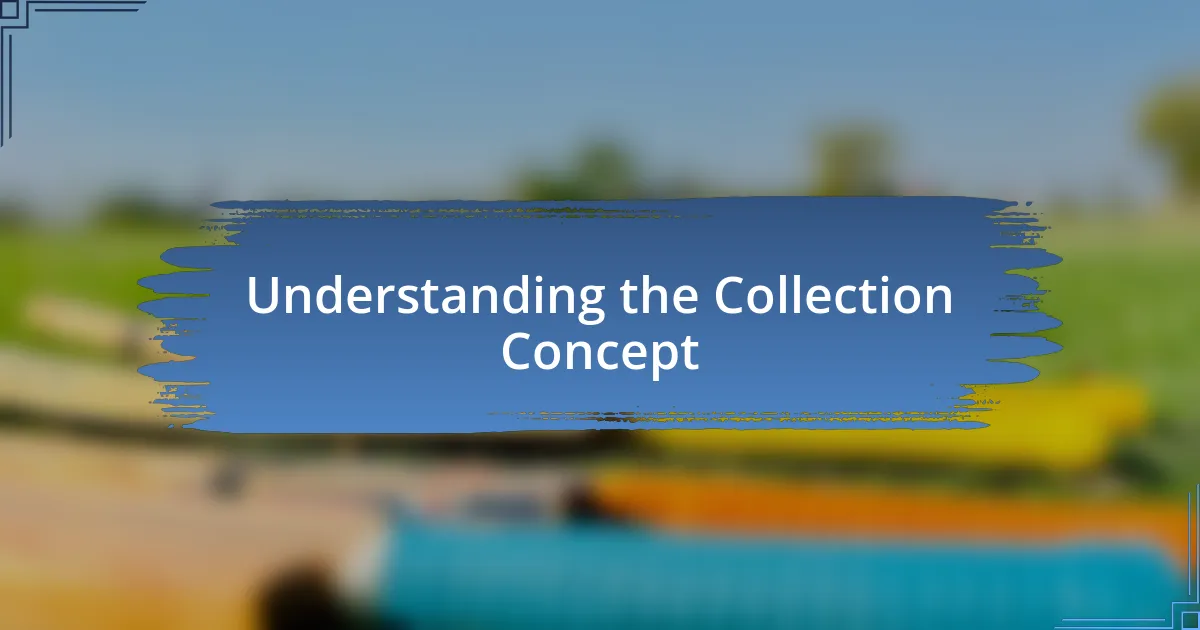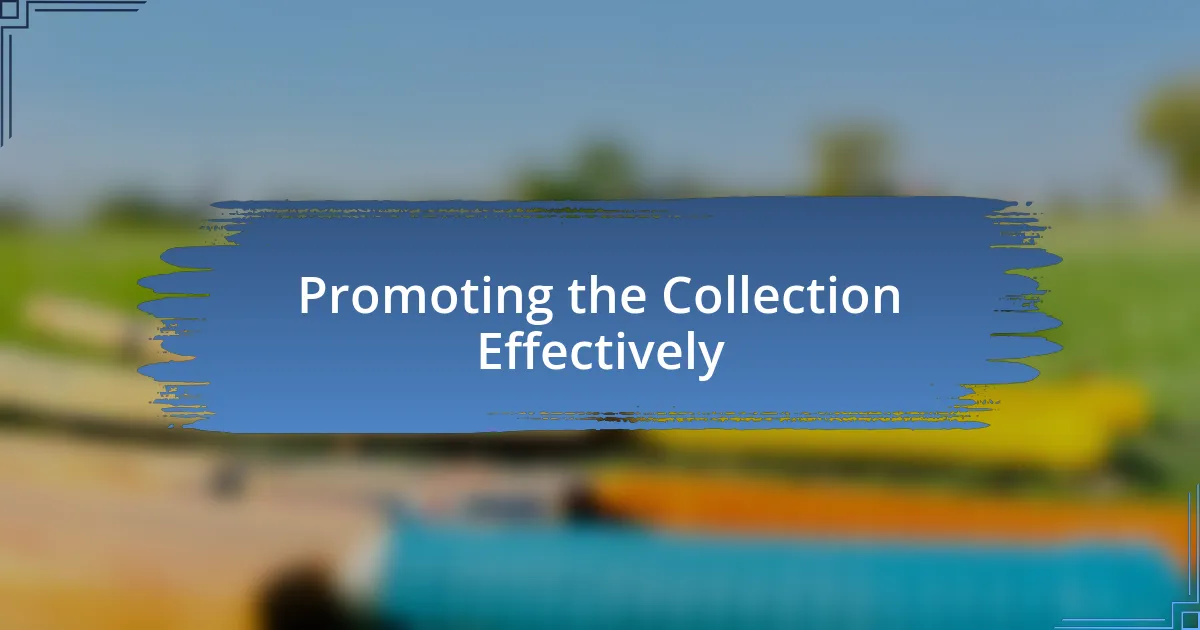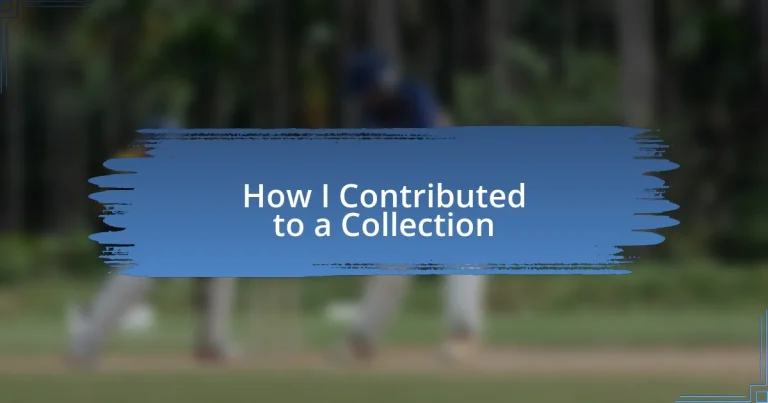Key takeaways:
- Collections tell personal stories and foster emotional connections, evolving alongside the collector’s journey.
- Collaborating with others enhances understanding and appreciation for the narratives behind collected items.
- Promoting a collection effectively involves sharing its story and engaging the community through genuine connections.
- Reflecting on experiences contributes to personal growth and builds relationships within the collectors’ community.

Understanding the Collection Concept
A collection, at its core, is more than just a group of items; it’s a narrative woven from individual experiences and passions. I remember the first time I realized this while curating my own collection of vintage postcards. Each card was like a window into a different world, stirring emotions and memories that made me appreciate their history even more deeply. Have you ever held something in your hands and felt a connection that transcended time?
What fascinates me is the idea that every collection tells a story not only about the items themselves but also about the collector. When I began adding rare stamps to my accumulation, I quickly discovered that each stamp was rich with cultural significance. It’s as if I was piecing together the puzzle of human connection across generations. How often do we sit back and think about what drives us to collect?
Moreover, a collection can evolve, much like personal growth. I started with a whim—gathering quirky ceramics—and ended up developing a keen eye for craftsmanship and artistry. As I delved deeper into what these pieces represented, I found myself transformed, embracing not just the objects, but the journey they had embarked upon. Isn’t it incredible how the act of collecting can lead to self-discovery?

Identifying Contribution Opportunities
Identifying the right opportunities for contribution is crucial in the world of collections. I learned this firsthand when I stumbled upon a local bazaar brimming with handmade crafts. It sparked a realization: not all contributions require grand gestures; sometimes, it’s about recognizing the potential in everyday moments. I found myself drawn to artisans who poured their hearts into their creations and realized I could amplify their stories through my collection.
To help identify these opportunities, I suggest considering the following:
- Explore local events: Keep an eye on craft fairs, exhibitions, or flea markets where unique items can be sourced.
- Engage with the community: Talk to fellow collectors, artists, or historians; their insights may guide you toward hidden gems.
- Research online platforms: Websites and social media can showcase individual stories behind collections and inspire new contributions.
- Visit museums and galleries: They often feature items that might not be on public display, offering a chance to discover untapped contributions.
- Follow your interests: Align your contributions with your passions; it makes the process more fulfilling and meaningful.
Every encounter can be a unique opportunity to enrich your collection and your understanding of the narratives behind it.

Selecting My Focus Area
Selecting my focus area came naturally after reflecting on my interests and the stories that resonated with me. I remember standing in a vibrant artisan market, captivated by a delicate ceramic piece. It spoke to my curiosity about the craftsmanship behind everyday objects. This moment solidified my desire to explore the intersection of function and art.
As I delved deeper into potential focus areas, I realized the importance of aligning my passions with the narratives of the items I wanted to collect. Each object should not only add to my collection but also contribute a unique perspective to my understanding of cultural stories. I began consistently asking myself: what do I want my collection to convey? It’s a deeply personal journey, one that requires introspection and an eagerness to learn from the artisans themselves.
To facilitate the process, I created a comparison table to help me weigh my options and make informed decisions regarding my focus area. This simple exercise clarified my priorities and solidified my commitment to a path that felt authentic and rewarding.
| Focus Area | Personal Connection |
|---|---|
| Ceramics | Connection to craftsmanship and cultural storytelling |
| Textiles | Interest in fabric designs and their historical significance |
| Jewelry | Appreciation for artistry and personal expression |

Collaborating with Other Contributors
Working with other contributors was a fascinating experience that truly enriched my understanding of my chosen focus area. I remember sitting around a table with fellow enthusiasts, each sharing our unique insights and perspectives. This exchange of ideas sparked creativity and made me realize how collaboration can elevate the storytelling behind each piece we curated together.
One of my most memorable moments involved brainstorming sessions where we dissected the historical context of our items. I found it intriguing to hear stories from another contributor about a textile piece that held deep familial ties for them. It made me reflect on the emotional weight behind the objects we collect—how they are not just artifacts, but vessels of personal history and connection. Have you ever experienced a moment when someone else’s story made you see an object in a whole new light?
Through these collaborations, I learned the value of diversity in our approaches. Each contributor brought different experiences and expertise, and our discussions often led to surprising discoveries. I began embracing feedback and suggestions, which helped me refine my thoughts and deepen my appreciation for the collective knowledge we possessed. It was a reminder that we’re all on this journey together, learning from one another and expanding our understanding of the cultural narratives woven into every piece of our collections.

Crafting My Unique Submission
Crafting my unique submission was a deeply personal journey that reflected not only my interests but also my emotions. I distinctly remember sitting at my desk, surrounded by notes and objects that held meaning for me. As I began to write, I found myself weaving in my childhood memories associated with the pieces I chose, creating a narrative that felt both personal and universal. Have you ever felt that rush of nostalgia when working on something that truly resonates with you?
It was essential for me to capture the essence of my inspiration. I poured over my collection, seeking items that had stories to tell—stories that echoed my own life experiences. For instance, I included a vintage camera that once belonged to my grandfather, a man whose passion for photography ignited my own love for capturing moments. This connection made my submission not just a presentation of facts but a vivid tapestry of shared memories and emotions.
Ultimately, the process was about authenticity. I aimed to craft something unique by blending facts with heartfelt stories, allowing readers to see the connection between the items and my narrative. I believe that when personal stories are intertwined with artifacts, they transform into a dialogue between the past and the present. How about you—what elements do you find essential in creating your own unique submissions?

Promoting the Collection Effectively
Promoting the collection effectively is about more than just displaying it; it’s about sharing the story behind each piece. I remember organizing a launch event where I invited friends and family to experience the collection firsthand. The excitement in the room was palpable as I recounted tales about the items, which made everyone feel more connected to the pieces and, in turn, to each other. Have you ever noticed how storytelling can transform a simple presentation into a memorable experience?
Utilizing social media was another game changer for me. I created dedicated posts that highlighted individual items, complete with their backstories and why they mattered to me. I encouraged my followers to share their own related experiences, fostering a sense of community. It’s fascinating how engaging with others can amplify the impact of a collection—when people see themselves in the stories, they’re more inclined to spread the word.
Moreover, I collaborated with local artists and influencers to reach a broader audience. Partnering with those who share similar values made the promotion feel authentic and organic. Engaging others in this way has taught me a vital lesson: sometimes, the best promotion is built on genuine connections and shared passions. How do you think collaborations can shape the narratives around collections?

Reflecting on the Experience
Reflecting on the experience of contributing to the collection, I find that it has profoundly shaped my understanding of both art and community. I vividly remember the moments of doubt when I questioned whether my contributions would resonate with others, but experiencing the joy on people’s faces when they connected with my pieces was immensely rewarding. Have you ever felt that surge of validation when your efforts are acknowledged?
As I look back, I realize that this journey taught me the importance of vulnerability in sharing my work. Each piece carries a part of my story, and I discovered that openness encourages others to share theirs. I felt a genuine connection to those who engaged with the collection, as though we were all part of a larger narrative weaving through our individual experiences.
Perhaps most striking was the realization that the process of contributing isn’t simply about showcasing talent—it’s about fostering relationships. I think about the conversations sparked by a single piece; it opened doors to understanding different perspectives, creating a tapestry of shared experiences. How often do we allow ourselves to be vulnerable enough to invite others into our creative spaces?


